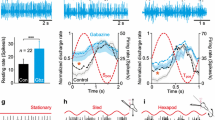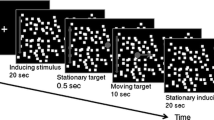Summary
1. Maximal activation directions of vertical burst-tonic and tonic neurons in the region of the interstitial nucleus of Cajal (INC) were examined in alert cats during vertical vestibulo-ocular reflex induced by sinusoidal rotation (at 0.11 Hz±10 deg, or 0.31 Hz±5 deg) in a variety of vertical planes using a null point analysis. The results were compared with the angles of anatomical and functional planes of vertical canals reported by Blanks et al. (1972) and Robinson (1982), and with the angles of vertical eye muscles measured in this study and by Ezure and Graf (1984). 2. Maximal activation directions of 23 cells (21 burst-tonic and 2 tonic neurons) were determined from their responses during rotation in 4 or more different vertical planes. All cells showed sinusoidal gain curves and virtually constant phase values except near the null regions, suggesting that their responses were evoked primarily by canal inputs. Phase values of 5 cells near the null regions depended on the rotation plane, suggesting additional otolith inputs. We used a measurement error range of ±10 deg for calculating the maximal activation directions from the null regions of individual cells and the values of error ranges of null calculation. Of the 23, the maximal activation directions of 7 cells were outside the measurement error ranges of vertical eye muscle angles and within the ranges of vertical canal angles (class A), those of 5 cells were within the ranges of eye muscle angles and outside the ranges of vertical canal angles (class B), and those of the remaining 11 cells were in the overlapping ranges for both angles (class C). Even if only the cells in which 5 or more measurement points were taken to determine maximal activation directions (n = 15), the results were similar. During vertical rotation with the head orientation +60 deg off the pitch plane, dissociation of cell activity and vertical compensatory eye movement was observed in 5 cells in class A or C that had null angles near +45 deg. These results suggest that the cells in class A and B carried individual vertical canal and oculomotor signals, respectively, although it is difficult to tell for the majority of cells (class C) which signals they reflected. Some cells in class A and C were antidromically activated from the medial longitudinal fasciculus at the level of abducens nucleus, suggesting that the signals carried by these cells may be sent to the lower brainstem. 3. Most burst-tonic neurons did not respond to horizontal rotation; significant responses were obtained in only 3 of 10 cells tested for which the gain was only 14–17% of their maximal vertical gain. There was no clear difference in gain or phase values of the responses to vertical rotation, or in eye position sensitivity (during spontaneous saccades) between cells whose responses coincided with individual vertical canal angles and those matching the angles of vertical recti muscles. The values of phase lag (re head acceleration during pitch rotation) and eye position sensitivity of these cells are still smaller compared to those of extraocular motoneurons reported by Delgado-Garcia et al. (1986), although they were larger than those of secondary vestibulo-ocular neurons (Perlmutter et al. 1988). All these results suggest that the signals carried by burst-tonic and tonic neurons in the INC region are different from oculomotor signals. 4. Similar analysis was done for comparison for 19 other cells that did not show close correlation with spontaneous eye movement but whose activity was clearly modulated by pitch rotation (pitch cells). More than a half (10/19) had maximal activation directions outside the measurement error ranges of individual vertical canal angles, and many shifted towards roll. Horizontal rotation produced responses with higher gain than burst-tonic neurons, suggesting a difference in the spatial response properties of burst-tonic and tonic neurons on one hand and pitch cells on the other.
Similar content being viewed by others
References
Anderson JH (1981) Behavior of the vertical canal VOR in normal and INC-lesioned cats. In: Fuchs AF, Becker W (eds) Progress in oculomotor research: developments in neuroscience, Vol 12. Elsevier/North-Holland, New York Amsterdam Oxford, pp 395–401
Anderson JH, Precht W, Papas C (1979) Changes in the vertical vestibuloocular reflex due to kainic acid lesions of the interstitial nucleus of Cajal. Neurosci Lett 14:259–264
Baker J, Goldberg J, Hermann G, Peterson B (1984a) Optimal response planes and canal convergence in secondary neurons in vestibular nuclei of alert cats. Brain Res 294:133–137
Baker J, Goldberg J, Hermann G, Peterson B (1984b) Spatial and temporal response properties of secondary neurons receiving convergent input in vestibular nuclei of alert cats. Brain Res 294:138–143
Baker J, Goldberg J, Peterson B (1985) Spatial and temporal response properties of the vestibulocollic reflex in decerebrate cats. J Neurophysiol 54:735–756
Baker J, Wickland C, Goldberg J, Peterson B (1988) Motor output to lateral rectus in cats during the vestibulo-ocular reflex in three-dimensional space. Neuroscience 25:1–12
Berman AL (1968) The brainstem of the cat: a cytoarchitectonic atlas with stereotaxic coordinates. University of Wisconsin Press, Madison Milwaukee London, pp 26–38
Boeder P (1961) The co-operation of extraocular muscles. Am J Ophthalmol 51:469–481
Blanks RHI, Curthoys IS, Markham CH (1972) Planear relationships of semicircular canals in the cat. Am J Physiol 223:55–62
Blanks RHI, Anderson JH, Precht W (1978) Response characteristics of semicircular canal and otolith systems in cat. II. Responses of trochlear motoneurons. Exp Brain Res 32:509–528
Cannon SC, Robinson DA (1987) Loss of the neural integrator of the oculomotor system from brain stem lesions in monkey. J Neurophysiol 57:1383–1409
Crawford D, Cadera W, Vilis T (1988). The coulomotor velocity to position transformation involves the nucleus of Cajal. Ann Meeting Soc Neurosci 14:956 (Abstr)
Delgado-Garcia JM, Del Pozo F, Baker R (1986) Behavior of neurons in the abducens nucleus of the alert cat. I. Motoneurons. Neuroscience 17:929–952
Estes MS, Blanks RHI, Markham CH (1975) Physiologic characteristics of vestibular first-order canal neurons in the cat. I. Response plane determination and resting discharge characteristics. J Neurophysiol 38:1232–1249
Ezure K, Graf W (1984) A quantitative analysis of the spatial organization of the vestibulo-ocular reflexes in lateral- and frontal-eyed animals. I. Orientation of semicircular canals and extraocular muscles. Neuroscience 12:85–93
Fuchs AF, Kaneko CRS, Scudder CA (1985) Brainstem control of saccadie eye movements. Ann Rev Neurosci 8:307–337
Fukushima K (1987) The interstitial nucleus of Cajal and its role in the control of movements of head and eyes. Prog Neurobiol 29:107–192
Fukushima K, Murakami S, Matsushima J, Kato M (1980) Vestibular responses and branching of interstitiospinal neurons. Exp Brain Res 40:131–145
Fukushima K, Ohno M, Takahashi K, Kato M (1982) Location and vestibular responses of interstitial and midbrain reticular neurons that project to the vestibular nuclei in the cat. Exp Brain Res 45:303–312
Fukushima K, Takahashi K, Fukushima J, Ohno M, Kimura T, Kato M (1986) Effects of lesion of the interstitial nucleus of Cajal on vestibular nuclear neurons activated by vertical vestibular stimulation. Exp Brain Res 64:496–504
Fukushima K, Fukushima J, Harada C, Ohashi T, Kase M (1990) Neuronal activity related to vertical eye movement in the region of the interstitial nucleus of Cajal in alert cats. Exp Brain Res 79:43–64
Fukushima K, Fukushima J, Ohashi T, Suzuki Y, Kase M (1989a) Adaptive change of vertical vestibulo-ocular reflex induced by tenectomy of vertical recti muscles and neuronal behavior related to vertical eye movement in the region of the interstitial nucleus of Cajal in alert cats. Brain Behav Evol 33:356–364
Fukushima K, Harada C, Fukushima J, Kato M (1989b) Spatial properties of vertical eye movement related burst-tonic and tonic neurons in the interstitial nucleus of Cajal (INC) region during vertical vestibulo-ocular reflex in alert cats. Neurosci Res Suppl Abstr S92
Fukushima-Kudo J, Fukushima K, Tashiro K (1987) Rigidity and dorsiflexion of the neck in progressive supranuclear palsy and the interstitial nucleus of Cajal. J Neurol Neurosurg Psychiatr 50:1197–1203
Graf W, Ezure K (1986) Morphology of vertical canal related second order vestibular neurons in the cat. Exp Brain Res 63:35–48
Henn V, Baloh RW, Hepp K (1984) The sleep-wake transition in the oculomotor system. Exp Brain Res 54:166–176
Kaneko CRS (1986) Location and discharge of saccade-related neurons in alert cat and monkey: developments in oculomotor research. Satellite meeting of International Union of Physiological Sciences (Abstr), p 78
King WM, Precht W, Dieringer N (1980) Synaptic organization of frontal eye fields and vestibular afferents to interstitial nucleus of Cajal in the cat. J Neurophysiol 43:912–928
King WM, Fuchs AF, Magnin M (1981) Vertical eye movement-related responses of neurons in midbrain near interstitial nucleus of Cajal. J Neurophysiol 46:549–562
King WM, Leigh RJ (1982) Physiology of vertical gaze. In: Lennerstrand G, Zee DS, Keller EL (eds) Functional basis of ocular motility disorders. Pergamon, Oxford New York Frankfurt, pp 267–276
McCrea RA, Strassman A, Highstein SM (1987) Anatomical and physiological characteristics of vestibular neurons mediating the vertical vestibulo-ocular reflexes of the squirrel monkey. J Comp Neurol 264:571–594
Nakao S, Shiraishi Y, Oikawa T (1986) Vertical eye movement-related neurons in the medial mesodiencephalic junction: their firing patterns, location and projection to oculomotor and trochlear nuclei. Neurosci Res Suppl (Abstr) 3:S66
Nakao S, Shiraishi Y, Oikawa T (1987) Vertical eye movement-related neurons in the cat mesodiencephalic junction: synaptic input from and output to the vestibular nuclei. Neurosci Res Suppl (Abstr) 5:S73
Perlmutter SI, Fukushima K, Peterson BW, Baker JF (1988) Spatial properties of second order vestibuloocular relay neurons in the alert cat. Ann Meeting Soc Neurosci (Abstr) 14:331
Peterson BW, Baker JF, Wickland C (1986) Plastic changes in cervicoocular and vestibuloocular reflexes elicited by labyrinthine lesions or altered visual feedback. In: Keller EL, Zee DS (eds) Adaptive processes in visual and oculomotor systems. Advances in the biosciences, Vol 57. Pergamon Press, Oxford, pp 399–408
Peterson BW, Graf W, Baker JF (1987) Spatial properties of signals carried by second order vestibuloocular relay neurons in the cat. Ann Meeting Soc Neurosci (Abstr) 13:1093
Robinson DA (1982) The use of matrices in analyzing the three-dimensional behavior of the vestibulo-ocular reflex. Biol Cybern 46:53–66
Author information
Authors and Affiliations
Rights and permissions
About this article
Cite this article
Fukushima, K., Harada, C., Fukushima, J. et al. Spatial properties of vertical eye movement-related neurons in the region of the interstitial nucleus of Cajal in awake cats. Exp Brain Res 79, 25–42 (1990). https://doi.org/10.1007/BF00228871
Received:
Accepted:
Issue Date:
DOI: https://doi.org/10.1007/BF00228871




